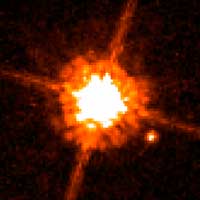Following hard on our discussion of HD 3651, a K-class dwarf whose brown dwarf companion was recently imaged, comes news that the Hubble Space Telescope has photographed something smaller still. CHRX 73 B orbits a low-mass red dwarf. Some would consider it a planet, others a brown dwarf; which camp you are in depends on what you use as a planetary marker. If it’s mass, then this object, 12 times the mass of Jupiter, would probably be considered a planet. But team leader Kevin Luhman (Pennsylvania State) has other ideas.
For if your marker is how the object formed, then a whole new set of criteria swim into view. Luhman argues that to be a planet, an object must have evolved from the gas and dust disk that circles a newly formed star. Whereas brown dwarfs are thought to form like any other star, from the collapse of huge clouds of hydrogen gas. They simply lack the mass to ignite hydrogen fusion in their cores.
And Luhman seems to be on firm ground in making this distinction:
“The object is so far away from its star that it is unlikely to have formed in a circumstellar disk. Disks around low-mass stars are about 5 to 10 billion miles in diameter. There isn’t enough material at that distance from the red dwarf to create a planet. Theoretical models show that giant planets like Jupiter form no more than about 3-billion miles from their stars.”

Image: This NASA Hubble Space Telescope image shows one of the smallest objects ever seen around a normal star. The brown dwarf candidate, called CHXR 73 B, is the bright spot at lower right. It orbits a red dwarf star, dubbed CHXR 73, which is a third less massive than the Sun. At 2 million years old, the star is very young when compared with our middle-aged 4.6-billion-year-old Sun. Credit: NASA, ESA, and K. Luhman (Penn State University).
Centauri Dreams‘ take: Brown dwarfs, we now know, are plentiful in the galaxy, and most do not orbit stars. Can brown dwarfs form planetary systems of their own? The Spitzer Space Telescope has detected several disks around brown dwarfs, but it’s impossible to tell whether CHRX 73 B has one or not — it’s too close to its primary to make the call. Disk or not, this find is a milestone in small object detection and reminds us that the boundaries between planet, brown dwarf and main sequence star are still very much in play.


I think perhaps anything much bigger then jupiter should be classified
as a brown dwarf star. This is based on mass. Likewise any thing at least as massive as pluto but not much more masive then jupiter should
classified a planet.
tim